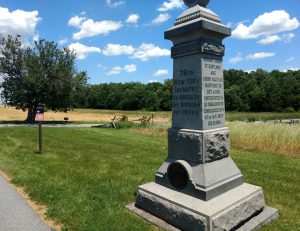Who Was First at Gettysburg?

When one thinks of the red corps badge of the First Division, First Corps of the Army of the Potomac, the mind immediately jumps to everyone’s favorite black hat wearing westerners, the First Brigade, the Iron Brigade. However, another group of men wore that same badge – the Second Brigade, First Division. These men served under the same corps badge but lacked the distinctive reputation. Though they were almost all hard-fought veteran regiments, they were only recently placed in the same brigade together by the time of Gettysburg. This brigade, under the command of Brigadier General Lysander Cutler, was comprised of the 76th New York, 56th Pennsylvania, 147th New York, 95th New York, 7th Indiana, and the 84th New York, better known as the 14th Brooklyn. The 7th Indiana was temporarily detached from the brigade to guard the wagon train and did not rejoin the others until after the fateful fighting on the first day, but the rest of the brigade faced hell on July 1 and never received the acclaim their sister brigade did. They led the division into combat at Gettysburg, but receive much less coverage in the historiography of the battle. Naturally, cavalry under Brigadier General John Buford were clearly the first Union troops engaged, but that didn’t keep (infantry) commanders and veterans from insisting the “real” battle didn’t start until infantry arrived. As such, arguments began about which element of the First Division arrived first and “opened” the battle.
On June 30, the Second Brigade led the column, spearheaded by the brigade guard and the 76th. That night, they bedded down just south of town. On July 1, it was the Iron Brigade’s turn to lead the column. However, the necessity of rapid movement paired with the fact that Cutler’s command was ready first meant that they stayed in the lead. Arriving northwest of town, the brigade split up. In order, the brigade guard, 76th, and 56th crossed the railroad cut and aligned on the ridge. The 147th received confusing orders and after having been cut off by Hall’s Battery barreling down the road, also crossed and deployed in an advanced position. The 95th and 14th deployed near the McPherson Farm. Various sources estimate that due to delays the Iron Brigade was over a mile behind. Cutler’s Brigade was the first Union infantry deployed on the fateful fields of Gettysburg.
They had little time to prepare before Confederate infantry arrived. William Mantayne of the 76th NY, still the lead regiment, remembered moving through town and deploying as he wrote a letter soon after the battle. “As soon as we got into Gettysburg, we were ordered to ‘double quick,’” he wrote, “and soon brought up in line of battle about a quarter of a mile west of the village. The enemy was seen advancing upon us and we opened fire upon them immediately.”[1] Lysander Cutler picks up the narrative from there in an 1863 letter to Pennsylvania Governor Andrew Curtin, recalling the first Union infantry volley at Gettysburg when he and Colonel John William Hofmann, commanding the 56th PA, spotted the enemy: “Being a few paces in rear of Col. Hofmann, he turned to me and inquired, ‘is that the enemy?’ My reply was yes.’ Turning to his men, he commanded, ‘ready-right–Oblique,-Aim,-Fire!’ and the battle of Gettysburg was opened. The fire was followed by other Regiments instantly, still that battle on the soil of Pennsylvania was opened by her own sons, and it is just that it should become a matter of history.”[2] Several veterans recall that the fight began while the lead regiment was still positioning itself under fire, leaving the honor of the first volley to the 56th. Mantayne was very clear about who was first on the field in his letter to a newspaper, declaring “Our Brigade was the only one up at this time; the 76th was leading the Brigade so we were the first in the fight.”[3]

The lead regiments of Cutler’s Brigade were torn to shreds in the next half hour. The 76th and the 56th found themselves on the end of the Union line, staring down the much larger 2nd Mississippi and 55th North Carolina. Due to the number of Confederate infantry, Mantayne recalled the enemy nearly enveloping them: “The enemy kept advancing upon us and outnumbered us so much as to out flank us on both right and left, and poured a tremendous cross fire into us.”[4] In this chaos, Major Andrew Grover, commanding the 76th and deserving of a blog post of his own, ordered his men to refuse the line, forming an “L” shape to face nearly twice their number from two directions. Soon, these two regiments were ordered to withdraw into the woods to their rear, and Grover fell dead during this withdrawal. Both contemporary and modern detractors have sometimes labeled this retreat as chaotic and unruly. I disagree. The 76th lost 65% of their number, while the 56th lost nearly 50%, which both displays their struggle and excuses some disorder. They would later reform and help to repulse later Confederate assaults including one by Brigadier General Alfred Iverson.
The 147th fared even worse. In a very isolated and advanced position, they never received the order to retreat. Practically surrounded by foes such as the 42nd Mississippi, they suffered over 75% casualties before they fled. At some point during this, the Iron Brigade finally arrived on the field. Most of the brigade was thrown into their own fight in Herbst Woods. Their 6th Wisconsin along with Cutler’s 95th NY and 14th Brooklyn soon launched the famous charge into the railroad cut in order to repulse the Confederates that had decimated the 147th NY.

In the aftermath of battle, Gettysburg became a turning point, a dramatic moment the public wished to remember and one that veterans wanted to be remembered as playing a key role during. Several veterans of the Iron Brigade began to assert that they were the Union infantry that started the fight there. Most of this debate played out in the pages of the National Tribune, a newspaper where Union veterans would share stories of their wartime experiences. Though most accounts were received well, sometimes veterans would vocally contest each other’s recollections, especially if they felt that another veteran’s column was impinging the honor or reputation of their unit. This occurrence is broadly and expertly covered in Steven E. Sondergren’s chapter, “’Exposing False History:’ The Voice of the Union Veteran in the Pages of the National Tribune” in the 2020 volume The War Went On: Reconsidering the Lives of Civil War Veterans. The spirited debate between veterans of the Iron Brigade and Cutler’s Brigade escalated when E.R. Reed of the 2nd Wisconsin Infantry emphatically declared the Iron Brigade in the lead, questioning where Cutler’s Brigade had been as he had not seen them.[5] Hofmann rebuked these claims, recalling that Cutler’s men had passed the Iron Brigade while they were still in bivouac and that the only reason some of their soldiers did not remember seeing the Second Brigade was simply because they were too far behind. Presenting a lengthy account of the day as he witnessed it, presenting additional evidence and concluding that he “never dreamt” that men of the 2nd Wisconsin would “attempt to rob the 56th Pennsylvania of the honors.”[6] Though this particular battle raged most heavily in 1884, other articles debating the claims appeared in 1887, 1891, 1892, and 1910. The 1892 dispute was particularly fervent, including B.H. Tripp of the 7th Wisconsin stated, “I have always claimed this for the First Brigade and always shall until some one makes it appear that I was not at Gettysburg at all,” only to be rebuked by H.H. Lyman of the 147th who called the article “so full of gross error that I am surprised at its publication.”[7]
To the Iron Brigade’s claim, Lt. Whitney of the 76th NY wrote “I do not wish to fight the battles over again, nor do I wish to claim laurels undeserved,” but added “nor will I permit one of our well earned feathers to be plucked from our hat.”[8] Both veteran accounts as well as later scholarship make it very clear that not only was Cutler’s Brigade first, but they held the line alone for a fair amount of time against a numerically superior foe. Perhaps the Iron Brigade found more success in Herbst Woods than the 76th, 56th, and 147th did along McPherson’s Ridge, but they only had time to arrive because of that sacrifice. This brigade rivalry and competing claims to glory were repeated in the writing of another event that fateful day. Both Rufus Dawes of the 6th Wisconsin as well as Edward Fowler of the 14th Brooklyn claimed that it was their idea to launch the charge on the unfinished railroad cut. In that case, the Iron Brigade won the battle over public memory, and the contributions of other units received less attention. These competing claims and spirited arguments show that although we may feel like we understand the timeline of the battle now, things were not always so clear. Nevertheless, both brigades of the 1st Division performed well on July 1st and Cutler’s Brigade, lacking distinctive uniforms or western identity deserves more credit than it receives.
[1] Wm. J. Mantayne, “Camp Correspondence – 76th Regiment N.Y.S.V. Westchester, Pa., July 6th“ https://dmna.ny.gov/historic/reghist/civil/infantry/76thInf/76thInfCWN.htm
[2] Lysander Cutler to Andrew Curtin, 5 November 1864. https://gettysburg.contentdm.oclc.org/digital/collection/p4016coll2/id/3226
[3] Wm. J. Mantayne, “Camp Correspondence – 76th Regiment N.Y.S.V. Westchester, Pa., July 6th“ https://dmna.ny.gov/historic/reghist/civil/infantry/76thInf/76thInfCWN.htm
[4] Wm. J. Mantayne, “Camp Correspondence – 76th Regiment N.Y.S.V. Westchester, Pa., July 6th“ https://dmna.ny.gov/historic/reghist/civil/infantry/76thInf/76thInfCWN.htm
[5] E.R. Reed, “The Second Wisconsin Sticks To Its Claim,” National Tribune, March 20, 1884 in Richard A. Sauers, Fighting Them Over: How the Veterans Remembered Gettysburg in the Pages of the National Tribune (Baltimore: Butternut and Blue, 1998).
[6] J. W. Hofmann, “General Hofmann Replies to the 2d Wisconsin’s Claim,” National Tribune, June 19, 1884 in Richard A. Sauers, Fighting Them Over: How the Veterans Remembered Gettysburg in the Pages of the National Tribune (Baltimore: Butternut and Blue, 1998).
[7] B.H. Tripp, “Substantiating the Claim That the Iron Brigade Opened the Battle,” National Tribune, September 22, 1892 and H.H. Lyman, “Cutler’s Brigade Opened the Battle – Claim of Iron Brigade Refuted,” National Tribune October 13, 1892 in Richard A. Sauers, Fighting Them Over: How the Veterans Remembered Gettysburg in the Pages of the National Tribune (Baltimore: Butternut and Blue, 1998).
[8] M.M. Whitney, “The 76th New York How it Opened the Fight on the First Day at Gettysburg,” National Tribune, July 21, 1887.
Great article. Lots I did not know about this part of Day 1. Thanks.
Thanks Raymond! It definitely doesn’t get as much attention as other aspects.
Excellent article. There is a little-known book called Cutler’s Brigade at Gettysburg that is essential reading on this . . .
Yes, I’ve got a copy. Long out of print and a little pricy to acquire, but worth it. Especially the revised second edition.